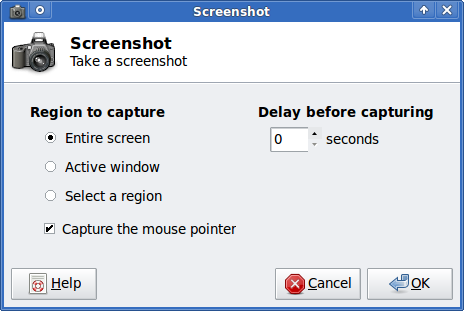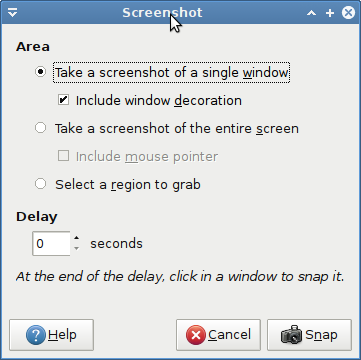 For my articles or the work I do every day I often have to make some screenshots to be included in the documentation, but until now had not found a program that fully satisfied … until today.
For my articles or the work I do every day I often have to make some screenshots to be included in the documentation, but until now had not found a program that fully satisfied … until today.
In this article i’ll show you some of the program i’ve used and tested and as last, the one that fit perfectly on my need.
So if you are impatience just jump at the end of the article, or continue and see what i’ve used so far.
Xfce4 Screenshooter
Using a Xubuntu, this was the first program I ever used. This application allows you to capture the entire screen, the active window or a selected region.
You can set the delay that elapses before the screenshot is taken and the action that will be done with the screenshot: save it to a PNG file, copy it to the clipboard, open it using another application, or host it on ZimageZ, a free online image hosting service.
A plugin for the Xfce panel is also available.
Pro:
Integrated in XFCE.
Easy to use.
Upload on remote site functionality integrated.
Cons
No edit of the image (crop, change) available.
Gimp
Many programs can take screenshots, but few are as good at doctoring the image after it’s taken as the GIMP is.
On the main panel, click on the “File” menu, and select “Create -> Screen Shot …” you’ll be presented with a windows like that on the right.
You can choose to take a screenshot of the whole screen or just a window, and you can set a delay in seconds.
After the delay in seconds the GIMP will takes a screen shot of whatever window you clicked on – if it isn’t at the front, the GIMP takes the shot with whatever other windows are overlaying it.
Pro:
Many opportunities to change a picture
Cons
Lack of function to do a remote upload
Too complicated to be used only to take a screenshot
Shutter
And finally I met shutter, I must say that this program is exactly what I wanted.
Shutter is a feature-rich screenshot program. You can take a screenshot of a specific area, window, your whole screen, or even of a website (uses gnome-web-photo to capture a website without opening a browser window) – apply different effects to it, draw on it to highlight points, and then upload to an image hosting site, all within one window.
This is the impressive list of his Edit options.
Especially if you are taking screenshots for writing tutorials or manuals you need to edit the image, e.g. highlighting some part of it. With Shutter you don’t need to open an external graphics editor like GIMP, because Shutter ships with its own built-in editor. Here are some of the most important features:
- Add Text, Arrows, Rectangles, Ellipses… The built-in editor allows you to add primitives (e.g. rectangles, lines etc.) , arrows or text to your screenshot. Every shape can be customized by changing the color, fonts and/or the line width.
- Censor / Pixelize to Hide Private Data – Don’t want to show sensitive data like IP or e-Mail addresses? Shutter gives you two simple but effective tools to hide this data.
- Auto-Increment Shape – When writing a step-by-step guide people often add incremental digits to the screenshots (usually via text). Shutter offers a specific auto-increment shape that can be added to the screenshot. It cannot be easier!
- Crop – The built-in editor also includes a tool to crop your screenshot. Simply select a region with your mouse or enter the desired dimensions into the input fields.
Share
We all spend much of our time in forums, wikis, chats etc. From time to time we need to do some screenshots and upload them so we can share them with other people.
Shutter includes the ability to upload images to a remote host and the latest version of supports Ubuntu One as well.
Pro:
Easy to use
Image editing functions designed for the screenshots
Upload on remote site functionality integrated.
Con
The only one I see is that it is not integrated into any window manager.
And since a video is better than many screenshots here is Shutter in action:
Popular Posts:
- None Found




What about
$ import file.png
then selecting the area to be grabbed?
`import` is part of the ImageMagick suite of tools. You can choose the file format just by changing the extension.
All those GUI tools over complicate this, IMHO.
Thanks John,
I’m a fan of the cli, and i agree import is really good, for a basic screenshot is perfect but my goal was to have something to do some basic editing of the image, and so far shutter is the best tool i’ve tested.
what about ksnapshot?
can shot fullscreen, window, region; with custom delay and automatic filenaming.
What about scrot ?
for example,on command line,
scrot -d 5 -c screen.jpg
SHUTTER is nice thanks for article.Also I know very simple and nice tool for make, edit, save and share screenshots http://xscreenshot.com
Very useful for games and share screenshots on forums, chats etc…